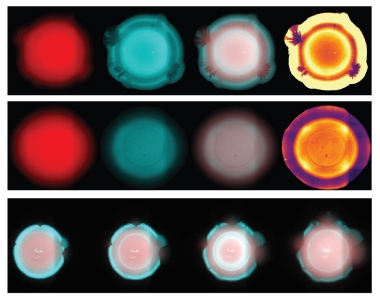By Rachel Scanza, Ph.D.
Cholera, a bacterial infection of the small intestine, has claimed countless lives for centuries. Currently, a seventh pandemic is wreaking havoc worldwide, infecting millions and killing over 100,000 people annually. The lab of Stowers Institute Assistant Investigator Ameya Mashruwala, Ph.D., is actively researching how the bacterium responsible for cholera, Vibrio cholerae, executes complex communal behaviors more commonly associated with the tissues of multicellular organisms like humans.
A recent study published in Proceedings of the National Academy of Sciences on November 5, 2024, identified a second parallel pathway of regulated cell death—a genetic or biochemical program that instructs certain cells to die in an orderly way—in V. cholerae bacterial communities. Led by Mashruwala and Howard Hughes Medical Institute Investigator and Squibb Professor of Molecular Biology at Princeton University Bonnie Bassler, Ph.D., the research, which was part of Mashruwala’s postdoctoral fellowship in the Bassler Lab, discovered new proteins guiding the “collective” decisions made by populations of bacteria.
“Our work, which identified new vulnerabilities in cholera-causing bacterial communities via innate bacterial cell death mechanisms, has broad implications,” said Mashruwala. “A greater understanding of bacterial cell death behavior may help us design strategies to disrupt it and lessen the severity of infections.”
Humans have five known cell death pathways, each with a distinct biological purpose. For instance, during development, tissues orchestrate the death of certain cells through a pathway called apoptosis, giving rise to functional body parts like eliminating the webbing that initially forms between fingers. A different form of cell death called pyroptosis is activated when cells detect viral or bacterial invaders. The infected cells die to prevent widespread infection.
In 2022, Mashruwala published a study identifying the first programmed cell death pathway in V. cholerae. This system, composed of a bacterial “nano weapon” resembling a syringe that injects toxic proteins into nearby cells and kills them, was previously thought to only kill competing species of bacteria. The team discovered, however, that the system can also be used to kill sibling cells. Finding this first cell death pathway was surprising. The discovery of a second V. cholerae cell death pathway raises questions on whether these programs in bacteria also serve biologically relevant functions like those in humans.
“Could bacteria use regulated cell death strategically for environmental adaptation and collective population survival?” asked Mashruwala, explaining that a key focus of his lab’s ongoing research at the Stowers Institute is to explore the benefits of these pathways for bacteria.
The genes the researchers discovered as driving the new cell death pathway had not been previously studied. Thus, many questions remain regarding how these genes trigger cell death and how, where, and when they are activated within the population. Research in the Mashruwala Lab is geared toward uncovering the genes’ molecular mechanisms that enable their functioning. A comprehensive mechanistic understanding aided by cross-disciplinary collaboration with the Stowers Technology Centers may be crucial in the fight against cholera.
“Our ultimate goal is to harness this understanding to develop tools for ‘on demand’ control over bacterial cell death,” said Mashruwala.
This work was supported by the Howard Hughes Medical Institute, the National Science Foundation (award: MCB-2043238), and by the National Institute of General Medical Sciences of the National Institutes of Health (NIH) (award: 5R37GM065859). The content is solely the responsibility of the authors and does not necessarily represent the official views of the NIH.



